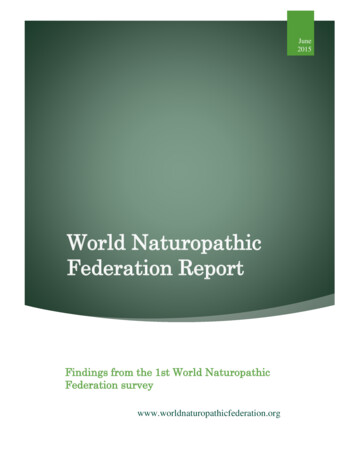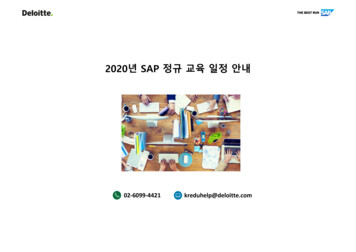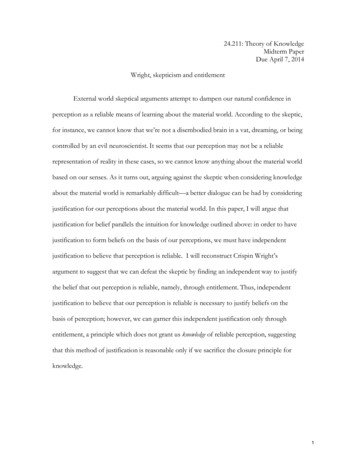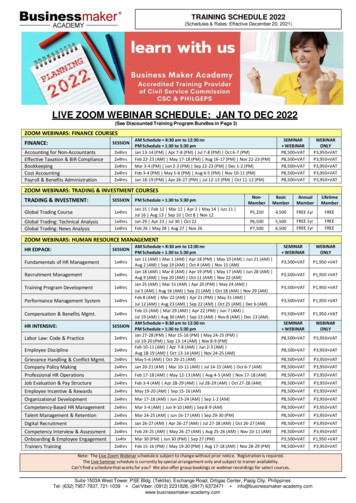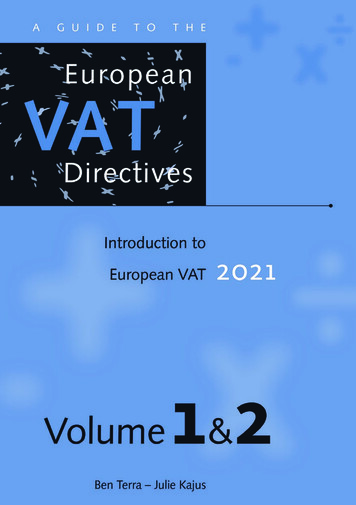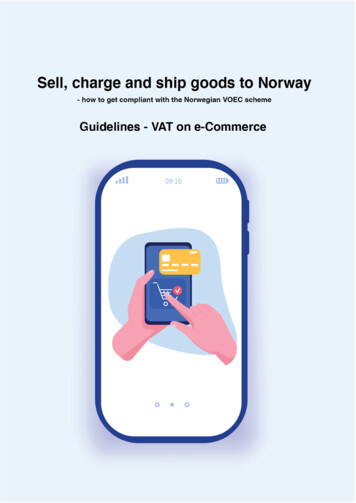
Transcription
1
Guidelines for VAT On Electronic Commerce (VOEC)Guidelines for VAT On Electronic Commerce (VOEC) . 21 Introduction . 32 Background. 32.1 Overview – the Norwegian VAT system . 42.2 VOEC scheme – VAT on low value goods . 53 VOEC scheme – key features . 54 More on the term “low value goods” . 74.1 Low value goods – The NOK 3,000 threshold . 74.2 Low value goods – multiple goods in one order – bundling . 85 Goods outside of VOEC-scope . 96 Basis for calculation of VAT on low value goods. 97 Who is liable for VAT – “supplier” of goods . 108 Safeguards – "good faith" – limited compliance risks . 119 Preventing double taxation – shipment information and labelling of shipments . 1210 VOEC scheme – administrative details . 1310.1 Who are entitled to register in the VOEC scheme and who are required to use ordinarydomestic VAT registration . 1310.2 How to register . 1410.3 When to register . 1510.4 Reporting and payment . 1510.5 Currency conversion – determining whether VAT applies to a supply . 1510.6 Currency conversion – determining the amount of VAT payable . 1610.7 Corrections – refunds – returns of goods . 1610.8 Point of sale. 1710.9 VAT deductions . 1710.10 Documentation and compliance requirements . 1710.11 Deletion from the simplified registration system . 1810.12 Administrative provisions – sanctions . 1811 Transitional provisions – sales that are made before 1 April 2020 . 1812 Advance registration in the VOEC scheme . 1913 Suppliers that chooses ordinary registration in the VAT Registry . 1914 More information – contact information . 19Appendix: Examples of foodstuffs, restricted goods and goods subject to excise duties in Norway 20Appendix: Import Guide to Norway . 22Appendix: Definition of "books" . 23Appendix: Information regarding sales of Collectables - Stamps, Coins and Banknotes . 24Appendix: Deciding the correct form of registration . 25Change log . 272
1 IntroductionNorway will abolish the exemption of VAT and other indirect taxes on low value goods sent fromforeign sellers to consumers in Norway. Norway is introducing a simplified VAT scheme for sellers andintermediaries such as online marketplaces. The suppliers will be liable for VAT on cross-border salesof low value goods to final consumers in Norway.The simplified VAT scheme will to enter into force as from 1 April 2020.The scheme is open for registration from 17 February 2020.The simplified scheme – called VOEC (VAT On E-Commerce) – is established for sellers and onlinemarketplaces to register, declare and pay VAT on business-to-consumer (B2C) supplies of low valuegoods.The scheme is an extension of the existing VOES scheme (simplified scheme for VAT on cross borderB2C sales of electronic services – VAT On Electronic Services). The VOEC scheme applies to bothsales of goods and electronic services. Going forward, the simplified scheme for both electronicservices and low value goods will be named VOEC.Sellers and marketplaces that already are registered in the VOES scheme, can use their currentregistration for reporting and payment of VAT on low value goods.2 BackgroundThe VOEC scheme is in accordance with principles in the OECD Guidelines on cross-border trade,especially the guidelines from 20171, and more recently, the report from March 2019 on the Role ofDigital Platforms in the Collection of VAT/GST on Online Sales.The VOEC scheme has similarities with the EU VAT e-commerce package that enters into force 1January 2021. In particular, the extension of the scope of the EU MOSS-scheme to encompassdistance sales of low value goods imported from third countries, and the abolition of the currentVAT exemption for imports of small consignments. The scheme also has similarities with theAustralian and New Zealand introduction of GST on low value imported goods from 1 July 2018 and 1December 2019 respectively. All of these models are simplified schemes that have been put in placefor sellers and online marketplaces to register, report and pay VAT/GST.1OECD (2017) International VAT/GST Guidelines, OECD Publishing. Paris.3
2.1 Overview – the Norwegian VAT systemNorway is not a member of the EU. Thus, the comprehensive secondary legislation as regards to VAT,especially the VAT directive Dir. 2006/112/EC, is not binding for Norway. Even so, the Norwegiansystem is largely based on the same principles as in the EU.VAT is payable on all goods and services unless specifically exempted, e.g. financial services, healthand social services and letting of real property, or zero-rated, e.g. books, newspapers etc.Foreign businesses with business activities in Norway must calculate and pay VAT to the same extentas Norwegian businesses.As regards to VAT on international transactions, the Norwegian system is highly influenced by theOECD work, both as regards the destination principle and as regards mechanisms for the effectivecollection of VAT. Norway was among the first countries to introduce a simplified vendor regime forB2C transactions of electronic services.Cross-border sales of goods and services are treated in accordance with the destination principle.Hence, imports to Norway are in principle VAT liable – except for the current exemption/threshold oflow value goods – through either border collection or use of the reverse charge mechanism or theVOES scheme, while exports from Norway are zero-rated. Please note that the VAT legislation appliesto the Norwegian mainland and all areas within the territorial border, but does not include Svalbard,Jan Mayen or the Norwegian dependencies. Sales to these areas are not subject to Norwegian VAT.The VAT rate structure is:-25% – Standard VAT rate-15% – Foodstuffs-12% – Personal transport, letting of rooms in hotels etc.-0% – Books, newspapers etc. (including electronic books and audiobooks)Foreign businesses are liable to registration in the Norwegian VAT Registry when VAT liable turnoverexceeds the registration threshold. The VAT registration threshold is 50,000 Norwegian Kroner (NOK)(approx. EUR 5,000, USD 5,500, CNY 38,000) during a 12 months period.Foreign businesses without place of business in Norway can register directly in the VAT Registry.However, if the country of establishment and Norway do not have an agreement on mutualadministrative assistance, the foreign business must register through a representative.4
The VOEC-scheme is an extension of the current scheme for electronic services called VOES (Vat OnElectronic Services). The VOES scheme is a simplified alternative to this ordinary registration process,and is provided to foreign businesses supplying electronic services to consumers in Norway. TheVOES scheme provides such businesses a simplified registration process, and simpler terms forcharging, collecting and remitting VAT to the Norwegian tax authorities. The VOES scheme is,broadly, an equivalent to the EU MOSS-scheme.2.2 VOEC scheme – VAT on low value goodsThe main element of the new scheme is that foreign sellers and intermediaries with a total turnover inNorway exceeding NOK 50,000 will be liable to pay Norwegian VAT when selling low value goods toconsumers in Norway. Zero rated goods – e.g. books – are to be included in the calculation of theturnover limit. If a seller uses an electronic marketplace to sell low value goods, only the operator ofthe marketplace will be regarded as the supplier for VAT purposes. This corresponds to the existingsimplified scheme for electronic services. For more information on when an intermediary shall beregarded as the supplier of goods, see point 7 “Who is liable for VAT –“supplier” of goods”.Foreign suppliers with turnover exceeding the NOK 50,000 threshold will be allowed to manage theirVAT liability on sales of low value goods through the VOEC scheme, instead of through an ordinaryregistration in the Norwegian VAT Registry. For information about registration in the VAT Registry, seepoint 10.1 and 14.Suppliers who do not exceed the registration threshold, and who are therefore not liable to payNorwegian VAT, but otherwise meet the requirements (i.e. carries out supply of goods comprised bythe VOEC scheme), may choose to register in the simplified registration system. The alternative forsuch supplies of goods is border collection of Norwegian VAT.3 VOEC scheme – key featuresThe key features of the VOEC scheme are:-The VOEC scheme will be only applicable for the collection of VAT.-The VAT liability on sales of low value goods (physical goods valued at less than NOK 3000)is shifted from the Norwegian consumer to the foreign supplier of the goods.-Instead of the consumers paying VAT at the point of importation (border collection), thesupplier must collect Norwegian VAT at the point of sale and report and pay the VAT toNorwegian tax authorities.-The VOEC scheme is a simplified “pay only”-system. VOEC-suppliers are not entitled to VATdeductions5
-The VOEC-goods are subject to simplified customs procedures, with no customs declaration.However, in order to avoid a second collection of VAT at the border the supplier must provideVOEC-information, showing that VAT has been collected at the point of sale. See point 9“Preventing double taxation – shipment – information and labelling of shipments”The VOEC scheme includes all goods, except:-Foodstuffs, which are any goods meant for human consumption, including nutritional anddietary supplements that are not medicinal drugs. Importation of medicinal drugs is restricted-Goods subject to excise duties, including tobacco products and alcoholic beverages. See herefor information on excise duties sation/vatand-duties/excise-duties/-Restricted or illegal goods according to Norwegian law. See here for information on restrictedgoods -import-restrictions/Zero-rated goods (newspapers, periodicals, books etc.) are included in the VOEC scheme. More onthe definition of "books" can be found in the appendix.The threshold for customs duties has been raised from NOK 350 to NOK 3,000 for goods where theobligation to collect Norwegian VAT is handled through the VOEC scheme. This means that no goodwithin the scope of the VOEC scheme will be subject to excise duties or customs duties.The VOEC scheme entails a simplified registration process, with simpler reporting requirements andfewer administrative burdens in general than an ordinary VAT registration.A supplier with an existing registration in the VOES scheme may use the same registration and“vendor ID” (registration number) for both electronic services and low value goods.Flow chart:6
4 More on the term “low value goods”The VOEC scheme is only applicable for sales of low value goods (and electronic services).Low value goods means:-Physical goods valued at less than NOK 3,000. (NOK 3,000 is equivalent to approx. EUR 300,USD 330, and CNY 2,300).4.1 Low value goods – The NOK 3,000 thresholdThe less than NOK 3,000 threshold is applied per item – not per consignment. The value of the item at“point of sale” is decisive. Additional costs and fees – e.g. shipping and insurance costs – areexcluded when determining if the value is within the NOK 3,000 threshold (but to be included whencalculating the VAT, see point 6 «Basis for calculation of VAT on low value goods”).Point of sale is when the consumer purchases the good, i.e. on checkout, when the customer acceptsthe total price and commits to the payment for the item.For the purpose of determining whether goods are individually valued less than NOK 3000, thesupplier must convert the sales price in foreign currency to NOK at the point of sale. See guidance forExample 1:Customer A buys a guitar for NOK 2,999 from Supplier B. The shipping charge is NOK 300. Supplier B mustcollect VAT according to the provisions on low value goods, as the value of the guitar excluding the shippingcharge is below the threshold. The shipping charge is to be included when calculating the amount of VAT tobe collected.Example 2:Customer A buys a sports item with retail price NOK 2,999 following currency conversion at the point ofsale according to the provisions for currency conversion. In the period between the point of sale and thepoint of importation, the exchange rate fluctuates which leads to the sports item’s value rising to NOK3,049 at the point of importation. The sports item is still within VOEC-scope, as the value was below thethreshold at the point of sale.Example 3:An underlying supplier misstates the value in e.g. transportation documents, which leads to the valueexceeding the threshold in the transport documents. The item is still within the VOEC-scope, as the value atpoint of sale is decisive.7
currency conversion below in point 10.5 “Currency conversion – determining whether VAT applies to asupply”.4.2 Low value goods – multiple goods in one order – bundlingA supply of multiple goods that individually has a value of less than NOK 3,000 is still considered a"supply of low value goods", even if the total value of the consignment exceeds the NOK 3,000threshold. The supplier must collect VAT on each item.On the other hand, if a supply of multiple goods consists of one or more goods valued above the NOK3,000 threshold, or one or more goods that fall outside of the VOEC scheme (e.g. foodstuffs orrestricted goods), the consignment must be split into separate consignments in order to avoid ordinarycustoms declaration of the low value goods.The same applies if a good within the VOEC scheme is bundled with goods outside the VOEC schemeand combined into one item.Any unbundling or separation of goods that are offered and sold as one unit to avoid passing the valuelimit of the VOEC scheme is prohibited.If items within the VOEC scheme and non-VOEC items are sold in the same transaction and sent inthe same consignment, the supplier can choose not to charge VAT for the item(s) within the VOECscheme, and make the whole shipment subject to border taxation. This possibility does not exempt thesupplier from registering in the VOEC scheme and charging VAT on items within the VOEC schemeon purchases or shipments that consist of only VOEC items.8
Example 4: Customer A buys a T-shirt for NOK 499, a jacket for NOK 1,999 and a pair of shoes for NOK 899from Supplier B. Supplier B must collect VAT on all items even if the total price exceeds NOK 3,000, as thevalue of each of the items is below the threshold.Example 5: Customer A buys a serving tray combined with foodstuffs. Presumed this make up a singlesupply of foodstuff; in this case the whole item is outside of the VOEC scheme. VAT, and any excise dutiesor custom duties, is subject to border collection.Example 6: Customer A in Example 4 adds a sports item worth 3,500 to the purchase ("items in basket").The items with an individual value below the threshold form one supply, and Supplier B collects VAT onthese items. The sports item falls outside of the VOEC scheme and the supplier chooses to send it in aseparate shipment subject to border taxation.Example 7:The supplier in example 6 wishes to send all the items (below and above the NOK 3,000 threshold) as oneshipment. The supplier chooses not to charge VAT to any of the items in the purchase. Thus, the wholeshipment and all items are subject to border taxation.5 Goods outside of VOEC-scopeGoods valued above the NOK 3,000 threshold, as well as foodstuffs, restricted goods and goodssubject to excise duties are treated according to current rules for importation of goods. Starting pointfor comprehensive information on customs legislation and procedures can be found here:https://www.toll.no/en/corporate/import/6 Basis for calculation of VAT on low value goodsThe basis for calculation of VAT on low value goods is the consideration. The VAT itself shall not beincluded in the basis of calculation. All costs relating to the performance of the agreement are includedin the basis for calculation of VAT, regardless of whether such costs are included in the considerationor are subject to a separate payment claim. For example, freight and insurance costs are included inthe basis for calculation of VAT. Discounts and Rebates that are pre-agreed and given directly inconnection with the sale, is subtracted from the basis of calculation.9
All reporting and payment must be done in NOK. See point 10.6 “Currency conversion – determiningthe amount of VAT payable” for guidance on determining the VAT payable amount.Example 8:Customer A buys a T-shirt for NOK 499, a jacket for NOK 1,999 and a pair of shoes for NOK 899 fromSupplier B. In addition, Supplier B charges NOK 299 for freight of the goods. The basis for calculation of VATis NOK 3,696. The amount of VAT collected is NOK 924.7 Who is liable for VAT – “supplier” of goodsIf a supplier of goods sells goods through its own online store etc., the supplier shall calculate and payVAT on the supplies.If the supply of the goods is facilitated with the use of an intermediary, the intermediary shall beregarded as the supplier for VAT purposes, instead of the underlying supplier of the goods. This,effectively, means that an operator of an online marketplace facilitating the distance sales of low valuegoods to consumers in Norway through the use of an electronic interface (e.g., marketplace, platform,app, portal), for VAT purposes will be regarded to have supplied those goods himself.The supplier provision is mandatory. This means that where an online marketplace (intermediary) isfacilitating the sale of low value goods, the underlying supplier cannot be registered for the salethrough the online marketplace. The underlying supplier and intermediary cannot freely choose whoshall be VAT liable for the supply.A supplier that sells goods within the VOEC-segment without the use of an intermediary – typicallyfrom its own web store – is liable for VAT and may use the VOEC scheme. If a supplier sells goodsboth via its own web store and through an intermediary who is regarded as the supplier for VATpurposes, the supplier is VAT liable for the sales via its own web store but not for the sales through theintermediary. For the latter, the intermediary shall calculate and pay VAT.Where low value goods are sold through an intermediary, it must be decided whether the underlyingsupplier or the intermediary shall be regarded as the supplier”. A general guideline for this assessmentis to determine which subject the consumer primarily deals with to buy the particular good. Generally,if the intermediary facilitates the sale of goods through an electronic interface, the intermediary shallbe regarded as the supplier of goods. Facilitate means that the intermediary, through the electronicinterface, allows the customer and underlying supplier to enter into contact that results in a supply ofgoods through the electronic interface to that customer. When carrying out this assessment, especiallythe following elements should be taken into account:10
-It is not decisive whether underlying agreements between the parties classify the relationshipas involving a subcontractor, intermediary, agent or commissioner etc.-It is not necessarily decisive who is contractually responsible for the supply of goods.-An important factor is who, from the standpoint of the consumer, appears to be the seller, andwho is responsible for the actual delivery.However, an intermediary shall not be regarded as the supplier if all of the following conditions aremet:-The intermediary does not set, either directly or indirectly, the general terms under which thesupply of goods is made;-The intermediary is not, either directly or indirectly, involved in charging the customer in respectof the payment made;-The intermediary is not, either directly or indirectly, involved in the ordering or delivery of thegoods.Additionally, an intermediary shall not be regarded as the supplier if the intermediary only provides anyof the following:-the processing of payments in relation to the supply of goods;-the listing or advertising of goods;-the redirecting or transferring of customers to other electronic interfaces where goods areoffered for sale, without any further intervention in the supply.This assessment is similar to the assessment made in the VOES-system in determining theresponsible party for VAT on sales of electronic services B2C, and is also designed in a similar way asin the EU system that enters into force 1 January 2021.A supplier with an existing VOES registration may use this registration to fulfil its obligations under thesimplified VOEC scheme for both low value goods and electronic services.8 Safeguards – "good faith" – limited compliance risksAn intermediary who is regarded as the supplier is fully liable for VAT on the supply of goods.The intermediary is in many cases dependent on information provided by underlying suppliers and thirdparties to comply with the VAT obligations. The intermediary shall not be held liable for the payment ofVAT in excess of the VAT, which is declared and paid on the supplies, where all of the followingconditions are met:11
-the taxable person (the intermediary) is dependent on information provided by suppliersselling goods through an electronic interface or by other third parties in order to correctlydeclare and pay the VAT on those supplies;-the information received by the taxable person is erroneous; and-the taxable person can demonstrate that he did not and could not reasonably know that thisinformation was incorrect.The customer shall be presumed to be a non-taxable person. This presumption releases the interfacefrom the burden of having to prove the status of the customer.9 Preventing double taxation – shipment information and labellingof shipmentsThe VOEC scheme is based on VAT collection at the point of sale, not border collection as in regularcross-border trade of goods B2C. Further, VOEC-goods are free of excise duties and customs duties.Consequently, there is no border collection of VAT, excise duties or customs duties for VOEC-goods.However, the border crossing may affect shipments within the VOEC-segment, as goods outside thescheme is subject to border collection of VAT, excise duties and customs duties. If the VOEC-goodscannot be easily identified, there are risks of delayed border crossing and double taxation. Thus, tosecure simplified importation and to avoid the risk of double taxation, the suppliers of VOEC-goodsmust take steps to ensure that relevant information about the VOEC-goods is available to thetransporter and, subsequently, the Norwegian Customs. The relevant information consists of thesupplier’s registration number (VOEC-number), which is assigned to the supplier upon registration inthe simplified VOEC scheme. This unique number must accompany the shipment as described below.It is vital that the information requirements are met in a way that secures that the information can beread, either digitally or physically, by the transporters and Norwegian Customs.The steps to provide relevant information are:Goods shipped by postal service: Preferable:oProvide the seven digit VOEC-number via electronic advance data(M33/ITMATT) when you book the shipment from your local postalservice.oMake sure this information is attached to a UPU standard S-10 barcodeon the item; and12
oUse labels CN 22 / 23 and provide the seven digit VOEC-number in thesender's address field. The VOEC-number must be labelled as "Sender'scustoms reference no" or “VOEC no”. Ensure there is 2 mm clear spacebetween the VOEC No and the line above. If ITMATT is not possible:oUse labels CN 22 / 23 and provide the seven digit VOEC-number in thesender's address field. The VOEC-number must be labelled as "Sender'scustoms reference no" or “VOEC no”. Ensure there is 2 mm clear spacebetween the VOEC No and the line above.Goods shipped by other carriers (courier, express shipping carriers):oProvide the seven digit VOEC-number via EDI message or labelling asinstructed by the shipping carrier.The transporters must make sure that the VOEC-information is available to the Norwegian Customs,preferably in a prenotification in digital form, alternatively – at the latest – upon presentation of thegoods at the border.If the above required VOEC-information is not included, the goods may still be submitted if thepackage includes proof (i.e. invoice including VAT) that VAT has been paid. This will however lead toa delay of delivery of the goods as well as risk of double taxation, and shall not replace the steps toprovide information required above.2A supplier or transporter in good faith is not held responsible for misuse of VOEC-numbers, see point8.10 VOEC scheme – administrative detailsThe VOEC scheme is an extension of the VOES scheme, and shares the requirements andadministrative provisions that are described below. These schemes are simplified vendor registrationschemes for the effective collection of VAT for suppliers who has no registered business address orresidence in Norway and shall only calculate and pay VAT on low value goods and electronic services.10.1 Who are entitled to register in the VOEC scheme and who are required touse ordinary domestic VAT registration2UPU (Universal Postal Union) member countries and their designated operators can provide the ITMATT ver.1.5.0 (both M33-11 and M33-12) with the assigned VOEC-number as the ITMATT reference –“sender.identification.reference”. If your designated operator uses the old ITMATT ver.1.2.1 (M33-8G) therespective field is “item.submitter-party.ID”.13
The term “supplier" is discussed above in point 7 "Who is liable for VAT – ‘supplier’ of goods”. Besidesthe definitions and distinctions discussed in that chapter, there are formal requirements for registrationin the VOEC scheme.The VOEC scheme is only applicable to suppliers that have no registered business address orresidence in Norway. Further, the VOEC scheme is only applicable to suppliers that shall onlycalculate and pay VAT on electronic services and low value goods.If a supplier has a registered business address or residence in Norway, or is VAT liable for any othersupplies of goods or services, the supplier must register in the ordinary VAT Registry for all of thesupplier’s taxable supplies, including low value goods. Such suppliers cannot opt for the simplifiedVOEC scheme. The same applies to suppliers that have a high degree of business adaptation towardsthe Norwegian market, and therefore are deemed to be domestic Norwegian businesses, even if theyotherwise fulfil the criteria for VOEC-registration. This may be the case after an overall assessment ismade, where key criteria are whether the supplier appear to be a Norwegian business from theviewpoint of a Norwegian consumer, the business predominantly is marketed and directed towardsNorway, and if the goods formally are considered delivered in Norwa
The suppliers will be liable for VAT on cross-border sales of low value goods to final consumers in Norway. The simplified VAT scheme will to enter into force as from 1 April 2020. The scheme is open for registration from 17 February 2020. The simplified scheme - called VOEC (VAT On E-Commerce) - is established for sellers and online






